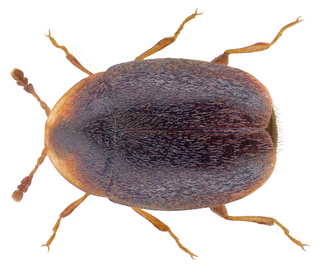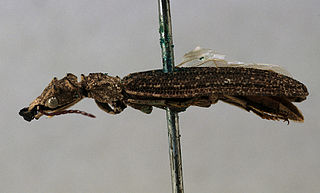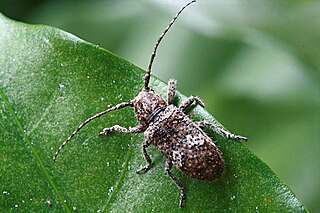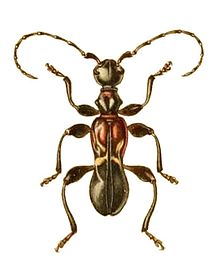
The longhorn beetles (Cerambycidae), also known as long-horned or longicorns, are a large family of beetles, with over 35,000 species described. Most species are characterized by extremely long antennae, which are often as long as or longer than the beetle's body. In various members of the family, however, the antennae are quite short and such species can be difficult to distinguish from related beetle families such as the Chrysomelidae. The scientific name of this beetle family goes back to a figure from Greek mythology: after an argument with nymphs, the shepherd Cerambus was transformed into a large beetle with horns.

Corylophidae is a family of minute hooded beetles, sometimes called minute fungus beetles, in the superfamily Coccinelloidea. There are about 18 genera and at least 120 described species in Corylophidae. They feed on microfungi such as molds, and are often found associated with bark, as well as in leaf litter and other decaying vegetation. In older literature, the family name was often given as Orthoperidae.
Jacob Rudolph Hendrik Neervoort van de Poll was a Dutch entomologist who specialised in Coleoptera. He was the vice-president of Artis, the Amsterdam zoo; a member of the Netherlands Entomological Society and the Société entomologique de France. The butterfly Troides vandepolli was named, by Samuel Constantinus Snellen van Vollenhoven, curator of the Leiden Museum, in his honour.

The Ommatidae are a family of beetles in the suborder Archostemata. The Ommatidae are considered the extant beetle family that has most ancestral characteristics. There are only seven extant species, confined to Australia and South America. However, the geographical distribution was much wider during the Mesozoic spanning across Eurasia and Australia, suggesting that they were widespread on Pangea. So far, over 26 extinct genera containing over 170 species of these beetles have been described. Three extant genera have been assigned to this family: Omma,Tetraphalerus and Beutelius. The family is considered to be a subfamily of Cupedidae by some authors, but have been found to be more closely related to Micromalthidae in molecular phylogenies. A close relationship with Micromalthidae is supported by several morphological characters, including those of the mandibles and male genitalia. Due to their rarity, their ecology is obscure, it is likely that their larvae feed on deadwood.
Acupalpus brunnicolor is an insect-eating ground beetle of the Acupalpus genus. It is the only Acupalpus species found in Australia, where its range is from Queensland, the Northern Territory, and Western Australia. It is an omnivorous, seed-eating insect with a length of 3-4 mm.
Elongatocontoderus fuscofasciatus is a species of beetle in the family Cerambycidae, and the only species in the genus Elongatocontoderus. It was described by Breuning in 1977.
Amblymora (=Australothelais) is a genus of longhorn beetles of the subfamily Lamiinae, containing the following species:
Ancita is a genus of longhorn beetles of the subfamily Lamiinae, containing the following species:
Bucynthia is a genus of longhorn beetles of the subfamily Lamiinae, containing the following species:

Callipyrga turrita is a species of beetle in the family Cerambycidae, and the only species in the genus Callipyrga. It was described by Edward Newman in 1842 using a specimen obtained by Rupert Kirk at Woodside near Sydney. This species is endemic to coastal eastern Australia from Townsville in Queensland down to Glenmore in New South Wales. The adult beetles are attracted to light and have been collected on Geijera parviflora and Flindersia xanthoxyla.

Rhytiphora is a genus of flat-faced longhorn beetles in the Pteropliini tribe of the subfamily Lamiinae. The genus was first described in 1835 by Jean Guillaume Audinet-Serville.
Ancita australica is a species of beetle in the family Cerambycidae. It was described by Stephan von Breuning in 1982. It is known from Australia.
Ancita similis is a species of beetle in the family Cerambycidae. It was described by Stephan von Breuning in 1938. It is known from Australia.
Ancita varicornis is a species of beetle in the family Cerambycidae. It was described by Ernst Friedrich Germar in 1848. It is known from Australia.
Bucynthia borchmanni is a species of beetle in the family Cerambycidae. It was described by Breuning in 1959. It is known from Australia.
Bucynthia marmorata is a species of beetle in the family Cerambycidae. It was described by Stephan von Breuning in 1963. It is known from Australia.

Rhytiphora bankii is a species of beetle in the family Cerambycidae. It was first described by Johan Christian Fabricius in 1775, under the genus Lamia. It is known from Australia, the Philippines, Borneo, Java, Micronesia, New Guinea, Hawaii, Moluccas, Sumatra, Vietnam, and has been introduced into Japan. The Australian species of Prosoplus were synonymised with Rhytiphora in 2013.

Myrabolia is the only genus in the beetle family Myraboliidae in the superfamily Cucujoidea. It has about 13 species, found in Australia. Adults and possibly larvae live under the bark of Eucalyptus trees.

Tasmosalpingus is the only genus in the beetle family Tasmosalpingidae. There are two species in Tasmosalpingus, found in Australia in Tasmania and Victoria. Adults have been collected using malaise traps, while a possible larval specimen was found under the bark of the podocarp Phyllocladus aspleniifolius. Gut contents indicate that they are mycophagous, feeding on fungal hyphae.

Bromiini is a tribe of leaf beetles in the subfamily Eumolpinae. The tribe contains approximately 120 genera, which are found worldwide. They are generally thought to be an artificial group, often with a subcylindrical prothorax without lateral ridges and covered with setae or scales.









